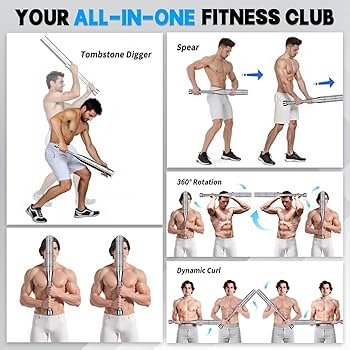Are you curious about how macebell training can transform your body? Wondering which muscles you’ll actually work when swinging that heavy club?
Understanding the specific muscles targeted can help you get the most out of every session. Whether you want to build strength, improve your grip, or boost your overall fitness, knowing how macebell training affects your muscles is key. Keep reading, and you’ll discover exactly what muscles are involved—and why this unique workout might be just what your routine needs.

Muscle Groups Targeted By Macebell Training
Macebell training uses a weighted mace to build strength and stability. It works many muscles at once. This training improves muscle control and coordination.
The uneven weight of the macebell challenges your muscles in new ways. It helps develop power and endurance across several muscle groups.
Shoulders And Deltoids
Macebell exercises heavily target the shoulders and deltoid muscles. The swinging motion requires strong shoulder control. This helps increase shoulder strength and mobility.
The deltoids work hard to stabilize the macebell during movements. This trains all three heads of the deltoid muscle for balanced development.
- Front deltoid for lifting the macebell forward
- Side deltoid for swinging and control
- Rear deltoid for pulling and stabilizing
Arms And Forearms
Macebell training strengthens the arms and forearms by gripping and swinging the mace. The wrists and grip muscles work constantly to hold the weight. This improves arm endurance and grip strength.
The biceps and triceps help control the mace’s path. Forearm muscles stay active to stabilize the wrist during dynamic moves.
- Biceps for bending the arm during swings
- Triceps for extending the arm
- Forearm muscles for grip and wrist control
Core Muscles
The core muscles are deeply engaged in macebell training. The uneven weight forces your abs and obliques to work hard. This builds core stability and balance.
Your lower back also supports the spine during movement. A strong core helps protect against injury and improves overall strength.
- Rectus abdominis for front core strength
- Obliques for twisting and side control
- Erector spinae for lower back support
Back And Lats
Macebell training activates the muscles of the back, including the lats. The pulling and swinging motions target these large muscles. This builds pulling power and upper body strength.
The rhomboids and traps also work to stabilize the shoulder blades. This helps improve posture and upper back endurance.
- Latissimus dorsi for pulling and power
- Rhomboids for shoulder blade movement
- Trapezius for neck and upper back control
Legs And Glutes
Though macebell training mainly targets upper body muscles, legs and glutes also get involved. Many movements require a strong stance and balance. The glutes help stabilize the hips during swings.
Leg muscles support your body weight while controlling the macebell’s motion. This helps improve lower body strength and stability.
- Gluteus maximus for hip stability
- Quadriceps for knee support
- Hamstrings for balance and control

How Macebell Enhances Muscle Strength
Macebell training uses a weighted club with a long handle. This tool challenges muscles in unique ways. It builds strength by making muscles work harder.
The swinging and holding movements activate many muscle groups. This type of training improves overall muscle power and control.
Improving Grip And Wrist Strength
Macebell exercises require a strong grip to control the weight. Holding the macebell forces your hands and wrists to work hard.
This constant tension helps build stronger forearm muscles. Strong wrists reduce injury risk and help with other sports and lifting.
- Improves hand and finger strength
- Builds wrist stability and control
- Enhances forearm muscle endurance
Building Explosive Power
Macebell swings use fast, powerful movements. These swings train your muscles to generate force quickly.
This type of power is important for sports and daily tasks. It helps muscles react faster and push harder.
- Develops fast-twitch muscle fibers
- Improves speed and strength
- Increases overall power output
Increasing Muscle Endurance
Macebell training involves many repetitions and sustained holds. This challenges muscles to work longer without getting tired.
Stronger endurance helps muscles perform daily activities and sports better. It also supports injury prevention by keeping muscles active.
- Builds stamina in muscles
- Supports longer training sessions
- Improves recovery and muscle health
Benefits Of Functional Muscle Activation
Macebell training targets many muscles at once. It helps your body move as one unit. This type of training activates muscles functionally.
Functional muscle activation improves how muscles work together. It makes daily movements easier and safer.
Improved Coordination And Balance
Macebell exercises challenge your body to stay steady. They require control of different muscle groups at the same time.
This improves your coordination and balance. You learn to move smoothly and stay stable during complex movements.
- Enhances hand-eye coordination
- Improves body awareness
- Helps prevent falls and injuries
Enhanced Joint Stability
Macebell training strengthens muscles around your joints. Strong muscles support and protect joints during movement.
This reduces stress on joints and lowers injury risk. Stable joints help you move freely and with less pain.
- Builds strength in shoulders, hips, and knees
- Supports healthy joint function
- Improves endurance of stabilizing muscles
Full-body Integration
Macebell moves use muscles across your whole body. They connect arms, core, and legs in one powerful movement.
This full-body activation improves overall strength and fitness. It trains your body to work better as a team.
- Engages core for stability
- Coordinates upper and lower body muscles
- Builds functional strength for daily tasks

Key Exercises And Their Muscle Focus
Macebell training uses a weighted club to build strength and stability. It targets many muscle groups through dynamic movements.
Below are key macebell exercises and the main muscles they work. These moves help develop power and control.
360 Swings For Shoulder And Core
360 swings involve swinging the macebell around your head in a circular motion. This exercise works your shoulders and core muscles.
The shoulders stabilize the macebell while the core controls your body’s rotation. This move improves balance and strength.
- Targets deltoids in the shoulder
- Engages obliques and abs in the core
- Works forearms and grip strength
Overhead Press For Delts And Triceps
The overhead press lifts the macebell above your head. This move focuses on the deltoid muscles and triceps.
Delts power the press while triceps extend the arms. This exercise also improves shoulder stability and arm strength.
- Strengthens front and side deltoids
- Builds triceps for arm extension
- Engages upper chest and traps slightly
Squats With Macebell For Lower Body
Squats with a macebell add resistance to your lower body workout. This strengthens legs and hips while improving balance.
Hold the macebell steady as you squat. It works your quads, hamstrings, glutes, and core for stability.
- Targets quadriceps and hamstrings
- Builds glute muscle strength
- Engages core for balance and posture
Macebell Rows For Back Strength
Macebell rows involve pulling the macebell towards your body. This focuses on your back muscles and helps posture.
The exercise works your lats, rhomboids, and traps. It also strengthens the arms and improves grip.
- Targets latissimus dorsi and rhomboids
- Builds trapezius muscle strength
- Strengthens biceps and forearms
Tips For Maximizing Muscle Engagement
Macebell training works many muscles in your body. To get the best results, you need to focus on muscle engagement. This means using the right form and effort during exercises.
Following some simple tips can help you activate more muscles. This will make your workouts more effective and help you build strength faster.
Proper Form And Technique
Good form is key to working the right muscles and avoiding injury. Keep your movements controlled and steady. Focus on how your muscles feel during each exercise.
Use a full range of motion and avoid swinging the macebell too fast. Keep your core tight and your posture straight to engage more muscle groups.
- Hold the macebell firmly but not too tight
- Keep your shoulders down and relaxed
- Breathe steadily through each movement
- Move smoothly, not jerking or rushing
Progressive Load And Intensity
To build muscle, increase the challenge over time. Add weight or do more repetitions as you get stronger. This forces your muscles to adapt and grow.
Start with a weight you can handle easily. Slowly raise the weight or the number of sets. This gradual increase helps prevent injury and improves muscle strength.
- Use heavier macebells as strength improves
- Add more sets or reps gradually
- Rest enough between sets for recovery
- Track your progress to stay motivated
Incorporating Variety In Workouts
Changing exercises helps engage different muscles. Use different macebell moves to work your whole body. This also keeps workouts interesting and fun.
Try swings, presses, and holds. Change your grip and stance to target muscles in new ways. Variety improves balance and muscle coordination.
- Mix overhead presses with side swings
- Use single-arm and two-arm exercises
- Vary your grip width and hand placement
- Combine macebell moves with bodyweight exercises
Frequently Asked Questions
What Muscles Are Targeted By Macebell Training?
Macebell training primarily targets the shoulders, forearms, and core muscles. It also engages the upper back, grip, and arm muscles for stability and control. This workout enhances functional strength and coordination across multiple muscle groups.
Does Macebell Training Improve Core Strength?
Yes, macebell training significantly improves core strength. The swinging and rotational movements engage abdominal and lower back muscles. This dynamic training enhances stability, balance, and overall core endurance.
How Does Macebell Training Benefit Shoulder Muscles?
Macebell exercises develop shoulder strength and mobility. They activate the deltoids, rotator cuff, and stabilizing muscles. The varied swinging motions improve joint stability and reduce injury risk.
Are Forearms Heavily Worked With Macebell Training?
Yes, macebell training intensely works the forearms. Gripping and controlling the macebell improve forearm strength and endurance. This results in better grip strength and wrist stability.
Conclusion
Macebell training targets multiple muscles for a full-body workout. Core strength improves with each swing. Shoulders, arms, and back muscles engage actively. Legs gain strength and stability, enhancing balance. This workout offers a dynamic approach to fitness. It’s versatile and effective for muscle building.
Anyone can incorporate it into their routine. Start slow and progress gradually. Consistency is key for seeing results. Enjoy the benefits of improved strength and endurance. Macebell training is a great addition to any fitness plan. Give it a try and feel the difference in your body.



